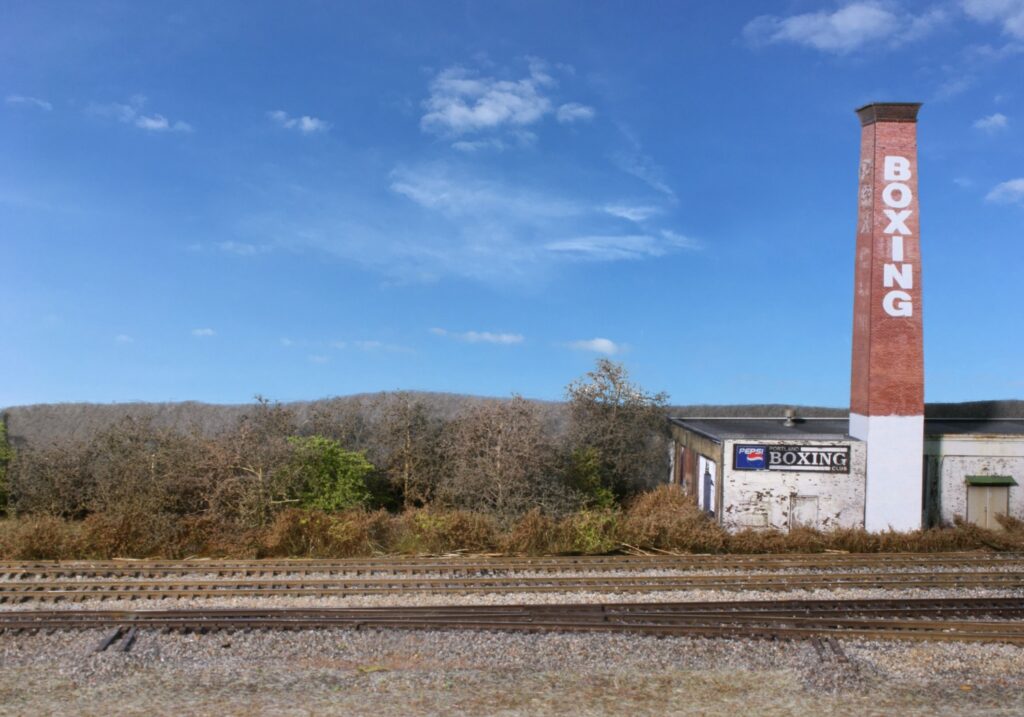
In this photo of a scene taken on the project currently in my shop, the emphasis was on put on the numerous scenery layers and matching the complex color patterns of the structure. At this point I haven’t added one traditional “detail” part such as a switch stand. When those parts are added, they will contribute far less visually than the efforts put into the scenery layer and structure coloring.
For those with short attention spans (like me): You will achieve the most visual impact if you associate the term “detail” with the number of color and texture layers of your scenery and structures and not with the number parts you dump into your scenes or the prototypical accuracy and number of bristling details you apply to your subject.
For many of us, our goal is to build better models. The better we do, the more satisfying the process is and the more we enjoy looking at the results of our efforts. We can’t move the bar however, if we don’t understand where to put our emphasis. To get the best results we need to understand which elements in the hierarchy carry the most weight in terms of visual impact. The catch all phrase “detailing” is one such example. If we don’t understand what we’re dealing with, we can spend a lot of time on things that are not at all noticeable or worse, do some damage visually.
In our model railroading universe the term “detailed” is linked one to one with “better”. In other words, the more detailed a model is, the higher the quality. As with anything, achieving success begins with how you define it. Detailing what?
Typically the subject of detailing is thought of in two ways. The first is sprinkling tons of “stuff” on the layout. The conventional wisdom being that the more trash cans, crates, barrels, tools, pallets, drums, etc. we pour into a scene the more “detailed” it is and, by direct association, the “better” it is. With this approach it is pretty easy to start sliding down the slope into caricature.
The other is defining it as having a placeholder for what exists on the prototype. The more delicate parts of the prototype we match, the better. This is fine “if” and it’s a big if, the model parts are finely detailed and not cast metal, flash laden, soap carvings. It’s a noble end and I admire the folks that are masters at it. While enjoyable and satisfying in its own right, such details often don’t carry much visual impact as far as the layout as a whole goes.
At some point it warrants examining our end game. Is it representing everything tit for tat? Or, is it visual impression? If it’s representation, representing what?
If it’s overall visual impact you’re after, then two other elements need to be brought into the discussion and put in front of the line ahead of “parts sprinkling” and “parts matching”. First is the number of “detailed” layers we add to scenery. The other is the number and accuracy of the color/weathering layers on our structures.
Mother Nature hasn’t made it easy on us. Representing nature effectively is probably the most difficult of all of the modeling tasks. Typically we stop with way too few color and texture layers. We make one pass of static grass and call things “done”. The end result is more like a carefully manicured golf course than the complex chaos of what you see by the typical rail right of way. Thinks in terms of five, six, or seven, scenery layers and colors starting from soil, then grass, then underbrush, and finally the trees.
Effective and detailed color detailing will catch the eye much more than the accuracy or existence of a given part. If you’re drawn to a masterfully done model locomotive you’re being pulled in by the modelers skill with subtitling adding color layers (weathering) not whether there is a whip antennae or not or whether the antennae is the right size or prototypically correct. The same goes for structures. An exceptional structure model is pulling you in more by its color layering and weathering than whether a window has eight versus ten panes.
These aspects of “detailing” are far more difficult to learn and carry off effectively. If a) you understand their importance and b) put the work in, the end results will pay enormous dividends.